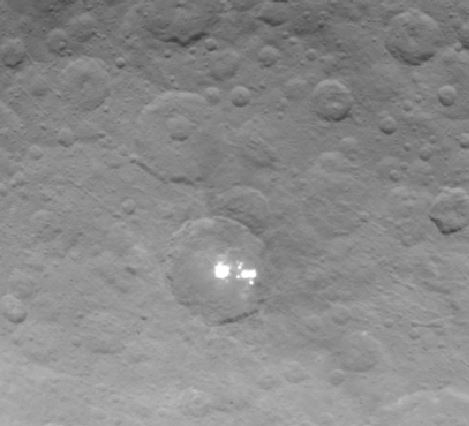The bright spots on the dwarf planet Ceres are caused by the reflection of sunlight and absolutely not by alien devices, investigators for the Dawn mission from the University of California, Los Angeles said.
In February this year, a photograph from NASA’s Dawn spacecraft showed two mysterious bright objects on the surface of Ceres in one of its craters. Scientists were surprised when just one bright object was seen. However, as the probe got nearer, another one was observed next to it. Nobody was able to explain what they were.
Several alien enthusiasts offered suggestions, from evidence of a cosmic beacon placed by a super-advanced civilization, to lights of a town like the ones seen from satellites orbiting the Earth.

The closer photos show that the two bright spots are, in fact, several bright spots. (Image: NASA)
Closer pictures provide more detail
The February pictures were taken almost 29,000 miles (46,000 km) from Ceres. On 3 and 4 May, Dawn took more pictures from just 8,400 miles away.
The new images show that the spots in the crater are actually composed of several smaller spots. Scientists are still not sure what causes them, but they are sure they have nothing to do with aliens. Most believe they are caused by ice.
Christopher Russell, principal investigator for the Dawn mission from the University of California, Los Angeles, said:
“Dawn scientists can now conclude that the intense brightness of these spots is due to the reflection of sunlight by highly reflective material on the surface, possibly ice.”
NASA says the new images (0.8 mile per pixel) offer scientists new insights into crater sizes and shapes, and a host of other fascinating geological features on the surface.
Dawn has just finished its first mapping orbit, in which it completed one 15-day full circle around Ceres while making several new observations with its scientific instruments.
The probe powered on its ion engine on 9 May to start the month-long descent towards its second mapping orbit, which it will enter on 6 June.
NASA wrote:
“In this next phase, Dawn will circle Ceres about every three days at an altitude of 2,700 miles (4,400 kilometers) – three times closer than the previous orbit.”
“During this phase, referred to as Dawn’s survey orbit, the spacecraft will comprehensively map the surface to begin unraveling Ceres’ geologic history and assess whether the dwarf planet is active. The spacecraft will pause twice to take images of Ceres as it spirals down into this new orbit.”
Dawn is the first spacecraft to visit a dwarf planet. It is also the first to orbit two different solar system targets. For a period of 14 months (2011 and 2012) it studied the giant asteroid Vesta, after which it left to study Ceres.
NASA Video – What is a dwarf planet?

